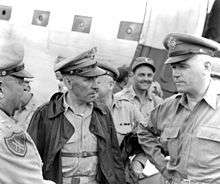John H. Church
Major General John Huston Church (June 28, 1892 – November 3, 1953) was a senior officer in the United States Army. He fought in World War I, World War II and in the Korean War. During the latter conflict, he provided assistance to the South Korean Army in the opening days of the war. He later commanded the 24th Infantry Division while it was engaged in the Battle of the Pusan Perimeter.
John Huston Church | |
|---|---|
 Church (center in leather jacket) with General Walton Walker and General J. Lawton Collins in Korea. | |
| Born | June 28, 1892 Glen Iron, Pennsylvania, United States |
| Died | November 3, 1953 (aged 61) Washington, D.C., United States |
| Buried | Arlington National Cemetery, Virginia, United States |
| Allegiance | United States of America |
| Service/ | |
| Years of service | 1917–1952 |
| Rank | |
| Unit | |
| Commands held | 157th Infantry Regiment 5th Infantry Division 24th Infantry Division United States Army Infantry School |
| Battles/wars | World War I World War II Korean War |
| Awards | Distinguished Service Cross Army Distinguished Service Medal Silver Star |
Early life
John Huston Church was born in the town of Glen Iron in Pennsylvania, on June 28, 1892.[1] From 1915 until 1917, he was a student at New York University.[2] After the American entry into World War I, Church volunteered for the United States Army and was commissioned as a second lieutenant. He served on the Western Front with the 28th Infantry Regiment, part of the 1st Division of the American Expeditionary Force (AEF).[1] He was wounded twice,[2] and was awarded a Distinguished Service Cross for heroism in action at the Battle of Cantigny.[3]
At the end of the war, Church decided to continue with his service in the army. He was aide-de-camp to Brigadier General F. C. Marshall in 1920 and, having been promoted to captain, a post as an instructor with the National Guard in Maryland followed. From 1933 to 1936, he served in the Philippines. In 1936, and by now a major, he returned to the United States to attend the Command and General Staff School for two years.[4] He later served with the Arizona National Guard as an instructor. In October 1940, he became the assistant chief of staff for operations of the 45th Infantry Division.[1]
World War II
After the United States entered World War II in December 1941, Church was appointed chief of staff, of the 45th Infantry Division.[5] He served with the division until late 1943, rising to assistant division commander (ADC),[4] during which time it was involved in the Allied invasion of Sicily, numerous battles in the Italian Campaign, and Operation Dragoon, the Allied invasion of southern France. At one stage, Church held a regimental command, when from late 1943 to mid-1944, he led the 157th Infantry Regiment.[5]
In September 1944, Church was promoted to the one-star general officer rank of brigadier general[1] and posted to the 84th Infantry Division as its ADC. Church was wounded again as his division took part in the advance from the Netherlands to the Elbe River towards the end of the war.[5]
Postwar
A year after the war ended, Church became the commander of the Infantry Replacement Training Center at Fort McClellan, Alabama. He was given the same post at Fort Jackson, South Carolina, where he later took command of the 5th Infantry Division. From 1948 until 1949 Church served as the deputy chief of Army Field Forces at Fort Monroe, Virginia. In 1950, he was serving in General Douglas MacArthur's headquarters in Tokyo as a section chief.[5]
Korean War
When the communist North Korean Army invaded South Korea on June 25, 1950, MacArthur sent Church to lead a survey team of staff officers to work with Ambassador Muccio and the Korean Military Advisory Group (KMAG) and assess what assistance could be provided to the South Korean Army. This task resulted in the establishment of GHQ Advance Command and Liaison Group (ADCOM) at Suwon.[6] Arriving in Korea on June 27, in his role as commander of ADCOM, Church worked with the Chief of Staff of the South Korean Army, General Chae Byung-dok, to improve the South Korean defensive arrangements. Despite his efforts, Seoul was captured by the North Koreans on 28 June and Church recommended the deployment of at least two combat teams of U.S. personnel to help stabilise the situation. This prompted MacArthur to undertake his own survey in Korea the following day and after a further report from Church, he committed U.S. forces to Korea, having received permission from President Harry Truman to do so.[7]
Accordingly, the 24th Infantry Division, which was stationed in Japan as part of the U.S. Eighth Army, was the first army unit sent over from Japan under the command of Major General William F. Dean. A reinforced company of the division, commanded by Lieutenant Colonel Brad Smith, was sent north from Pusan to try to halt the North Koreans. Meeting with Smith at Taejon, Church informed him "All we need is some men up there who won't run when they see tanks",[8] and instructed Smith to make his stand at Osan.[9] Task Force Smith was without tank support and had faulty communications, and was promptly overrun in its first engagement with the North Koreans. Dean gathered his troops in the city of Taejon and formed a strong defense. After a stubborn fight, the American troops retreated. Dean got separated from his troops and was captured. On July 22, Church, without a command following the dissolution of ADCOM, was given command of the division.[10]
His new command was given a two-day period to rest, but then Lieutenant General Walton Walker, the commander of the U.S. Eighth Army, decided that he needed the 24th to guard the Southwest line (the Naktong Bulge) of the Pusan Perimeter. During the subsequent battle, the North Korean 6th Division inflicted more losses on Church's men and gradually pushed the 24th back. Finally, Church by now promoted to major general, was able to regroup his men, and they held the perimeter, especially with the help of a brigade of marines.
Frail and suffering from arthritis,[5] Church remained in command of the 24th until January 25, 1951. His health meant that he was not often in the field and Lieutenant General Matthew Ridgway, commander of the U.S. Eighth Army following the death of Walker in December 1950, considered this was detrimental to the state of the division. Ridgway relieved Church of his command[11] and replaced him with Brigadier General Blackshear M. Bryan.[12] Church was awarded the Army Distinguished Service Medal for his leadership of the 24th Division while in Korea.[13]
Later life

Church subsequently was appointed commandant of the U.S. Army Infantry School at Fort Benning, Georgia[14] and served in that capacity until his retirement from the military in June 1952. He died on 3 November 1953 in Washington, D.C. Survived by his wife, he was buried in Arlington National Cemetery, in Virginia.[15]
References
- "US Army Officers 1939–1945". Retrieved 15 August 2011.
- Taafe 2016, p. 24.
- "John H. Church: Distinguished Service Cross". Military Times. Sightline Media Group. Retrieved 3 June 2018.
- Taafe 2016, p. 25.
- Blair 1987, p. 73.
- Weintraub 2001, pp. 45-51.
- Matray 1991, pp. 103–104.
- Weintraub 2001, p. 63.
- Halberstam 2007, p. 45.
- Blair 1987, pp. 141–142.
- Taafe 2016, p. 156.
- Taafe 2016, p. 159.
- "John H. Church: Army Distinguished Service Medal". Military Times. Sightline Media Group. Retrieved 3 June 2018.
- "New Command Team in Korea". Time. 5 March 1951. Retrieved 15 August 2011.
- "John Huston Church Major General, United States Army". Arlington National Cemetery Website. Retrieved 3 June 2018.
Sources
| Wikimedia Commons has media related to John H. Church. |
- Blair, Clay (1987). The Forgotten War: America in Korea, 1950–1953. New York: Times Books. ISBN 0-8129-1670-0.CS1 maint: ref=harv (link)
- Halberstam, David (2007). The Coldest Winter: America and the Korean War. New York: Hyperion. ISBN 978-1-4013-0052-4.CS1 maint: ref=harv (link)
- Matray, James I. (1991). Historical Dictionary of the Korean War. New York: Greenwood Press. ISBN 978-0-313-25924-1.CS1 maint: ref=harv (link)
- Taaffe, Stephen R. (2016). MacArthur's Korean War Generals. Lawrence, Kansas: University Press of Kansas. ISBN 978-0-7006-2221-4.CS1 maint: ref=harv (link)
- Weintraub, Stanley (2001). MacArthur's War: Korea and the Undoing of an American Hero. New York: Touchstone. ISBN 0-7432-0503-0.CS1 maint: ref=harv (link)
| Military offices | ||
|---|---|---|
| Preceded by Newly activated post |
Commander, 5th Infantry Division July 1947 – October 1947 |
Succeeded by William B. Kean |
| Preceded by William F. Dean |
Commander, 24th Infantry Division July 1950– January 1951 |
Succeeded by Blackshear M. Bryan |
| Preceded by Withers A. Burress |
Commandant of the United States Army Infantry School 1951–1952 |
Succeeded by Robert Nicholas Young |